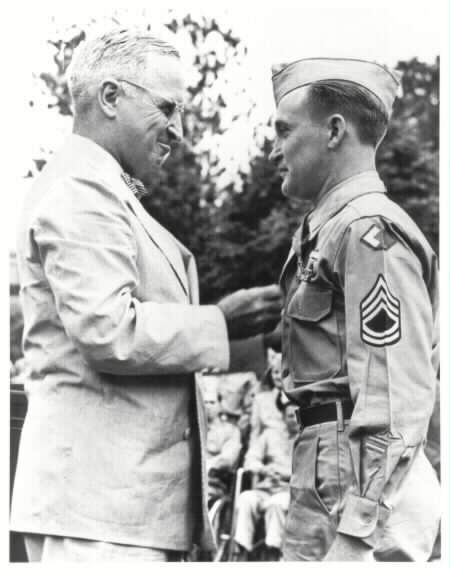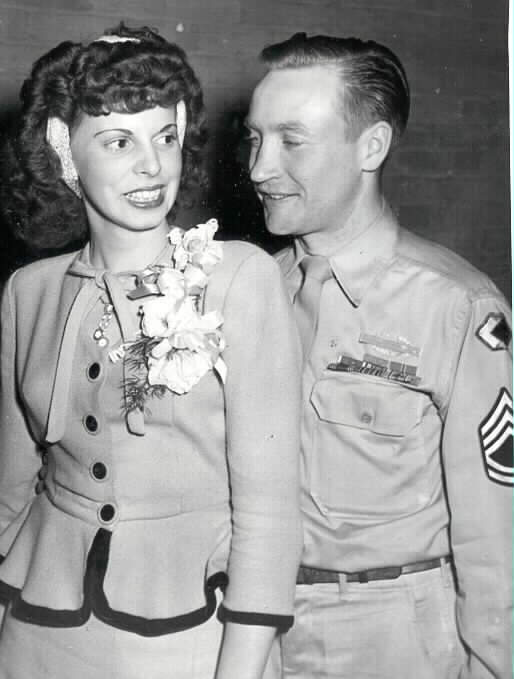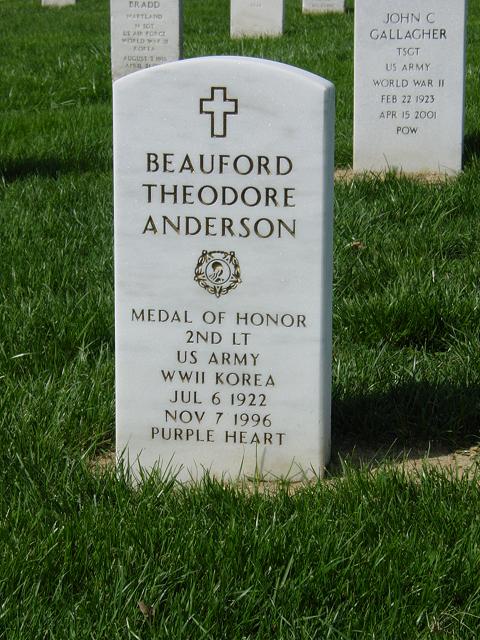Army Reserve to Honor Medal of Honor Recipient — Again
By Lieutenant Colonel Randy Pullen Office of the Chief,
Army Reserve Public Affairs and Liaison Directorate
WASHINGTON (March 22, 2001) — The Army Reserve is planning to honor a World War II Medal of Honor hero for the second time in six months.
A ceremony will be held on May 7, 2001, to re-inter the remains of Beauford T. Anderson and his wife, Phyllis, at Arlington National Cemetery. The urns of the couple are being transferred from California. They died within weeks of each other in 1996.
Anderson received the nation’s highest award for combat heroism for his actions on Okinawa in April 1945. Anderson, then a staff sergeant in the 96th Infantry Division (Organized Reserve), was credited with single-handedly defeating a predawn Japanese counterattack against his unit.
After emptying his carbine at the charging Japanese, Anderson then hurled a dud enemy mortar round at them, which exploded in their midst. He then began to pull the safety pins on American mortar rounds, arm them by banging the bases on rocks and threw these now-live rounds at the enemy, finally forcing them to retreat. Although seriously wounded, he insisted on personally reporting back to his company commander before allowing himself to be treated for his wound.
Okinawa was the second World War II campaign for this courageous non-commissioned officer. During the Leyte campaign in late 1944, Anderson received the Bronze Star Medal for crossing open terrain under enemy fire to pull two wounded soldiers to safety and give them first aid until litter bearers could evacuate them.
On Memorial Day 1946, in a ceremony at the White House, President Harry S Truman placed the Medal of Honor around the neck of Technical Sgt. Anderson. Of the five 96th Infantry Division soldiers to receive the Medal of Honor in World War II, only Anderson and Pfc. Clarence Craft survived to receive their Medals in person.
After the war, this Wisconsin native moved to California. There, he served two terms as mayor and two terms as a city councilman of Seaside, Calif. He continued to serve his country as an Army Reserve warrant officer and then as an Army Reserve second lieutenant until his wartime wounds forced his medical retirement. Anderson also served two terms as a Monterey County (California) Supervisor and one year as Chairman of the Board of Supervisors. He owned a cattle ranch next to Hunter-Liggett, California and lived the last years of his life in Salinas, California. He died on November 7, 1996. His wife of 50 years, Phyllis, died on December 23, 1996.
On December 15, 2000, the new $15.3 million dollar, 218-room dormitory of the Army Reserve Readiness Training Center at Fort McCoy, Wis., was dedicated. This state-of-the-art facility at the Army Reserve’s premier training site was named Beauford T. Anderson Hall.
At the ribbon-cutting ceremony, Major General Thomas J. Plewes, Chief, Army Reserve, explained why it was so appropriate to name this building after Anderson.
“Beauford T. ‘Andy’ Anderson truly was a great citizen-soldier,” Plewes said. “Like every soldier, he understood the value of good training and how to be a good trainer and leader. It all begins with training.
“That’s why the Army Reserve has devoted the resources to creating a training facility at Fort McCoy. Our soldiers deserve the best facilities we can provide them and the best training we can give them. That’s exactly what we have here.”
It was during the ceremony at Fort McCoy, which was attended by Anderson’s son, James Anderson, that it was learned that Beauford Anderson had not received the honors a Medal of Honor recipient was entitled to when he died. Anderson had always been very modest about his heroism and most in his community did not realize how great a hero lived among them.
After discussing this with the family, and at their request, the Army Reserve made
arrangements to re-inter the Andersons in some of America’s most hallowed ground, Arlington National Cemetery.
Prior to the re-interment, a tribute service will be conducted at the Old Post Chapel on Fort Myer, Va., at 1:00 p.m., followed by the full military honors befitting a Medal of Honor recipient at Arlington Cemetery.
The Army Reserve Readiness Training Center has created an excellent website for those wishing to learn more about Beauford T. Anderson and Beauford T. Anderson Hall.
Courtesy of the United States Army Reserve Readiness Center:
The Making of An American Soldier
At the time of his enlistment, Beauford T. Anderson was a lifelong Wisconsin resident. He was born in Eagle River, Wisconsin, on 6 July 1922, and joined the Army at Soldier’s Grove, Wisconsin, in 1942. Anderson was assigned to the newly activated 96th Infantry Division, which was ordered into active military service on August 15, 1942. Anderson trained with the 96th at Camp Adair, Oregon. Later during training, the Division was headquartered at Camp Beale, California. Hans Kaufman knew Beauford Anderson well during the months of training. He said of Anderson, “he was always teaching us something– teaching us to survive, and teaching us to be better soldiers.” Looking out for his buddies, both in training and in combat, just seemed a natural style for Anderson.
The 96th Infantry Division finally completed preparation and went to war, embarking for the Pacific Theater during July of 1944. At first, the division practiced amphibious landings at Maui, in Hawaii. A few months later, in October, the men of the 96th hit the beaches at Leyte as part of the effort to retake the Philippines. During the fighting on Leyte, the 96th Division saw plenty of action– almost too much. The division killed some 7,700 enemy soldiers and accomplished every mission assigned to them. The cost was 1,800 battle casualties and another 2,500 killed or injured due to illness or accidental injury.
During the fighting at Leyte, Staff Sergeant Beauford Anderson — then Sergeant Anderson– performed an act of valor that resulted in a Bronze Star. The citation reads, in part, “Anderson crossed fifty yards of terrain under enemy observation and intense fire and rescued two wounded men from the scene of action, removing them to an area of comparative safety where he administered first aid until litter bearers arrived.”
The account of Anderson’s heroism on Okinawa has already been given in detail, and will not be repeated here. But even though the war ended for Anderson when he received his combat injury, he contribution to the U.S. Army did not end in the Pacific. About that, more later.
On Memorial Day of 1946 the former Technical Sergeant Beauford T. Anderson, now a civilian, received the Medal of Honor from President Harry Truman. The ceremony was on the White House grounds, and Mr. Anderson was in the company of four other Medal-of-Honor recipients. Mr. Anderson was the first member of his regiment to receive the Medal of Honor. He was one of two members of the 96th Infantry Division to receive the Medal of Honor as a result of the fighting for Kakazu on Okinawa. All told, five members of the 96th Division received the Medal of Honor for combat in the Pacific. Only two of these men — Beauford Anderson and Clarance Craft — survived the war.
Upon first returning home after the war, Beauford Anderson lived for a while in Beloit, WI, then moved to Mackinaw Island, Michigan. He finally relocated to Seaside California, where in later years he served a term as mayor. During his years in California, B.T. Anderson, now a Warrant Officer, continued to serve his country in the U.S. Army Reserve. It is a testimony to the modesty of Anderson that very few people in Seaside were aware that he had received the Medal of Honor. He was simply too modest to mention it.
Staff Sergeant Beauford Anderson typifies the spirit of most soldiers of the 96th Infantry Division, who generally were not career soldiers, but rather, enlistees or draftees. They were taken from all walks of life, and they were handed a mission that demanded bitter sacrifice. These men took on and executed that mission with nobility of spirit. At Okinawa, the 96th Division’s greatest challenge, the combined battle fatalities of the Army, Marines, and Navy totaled 14,005, with another 32,500 wounded. A significant percentage of these casualties were incurred by the men of the 96th, the division which was in the center of the attacking line during the bitter early weeks of the drive south. The 96th incurred the worst casualties of any division that fought on Okinawa.

ANDERSON, BEAUFORT T.
Rank and organization: Technical Sergeant, U.S. Army, 381st Infantry, 96th Infantry Division. Place and date: Okinawa, 13 April 1945. Entered service at: Soldiers Grove, Wisonsin. Birth: Eagle, Wisconsin. G.O. No.: 63, 27 June 1946.
Citation:
He displayed conspicuous gallantry and intrepidity above and beyond the call of duty. When a powerfully conducted predawn Japanese counterattack struck his unit’s flank, he ordered his men to take cover in an old tomb, and then, armed only with a carbine, faced the onslaught alone. After emptying 1 magazine at pointblank range into the screaming attackers, he seized an enemy mortar dud and threw it back among the charging Japs, killing several as it burst. Securing a box of mortar shells, he extracted the safety pins, banged the bases upon a rock to arm them and proceeded alternately to hurl shells and fire his piece among the fanatical foe, finally forcing them to withdraw. Despite the protests of his comrades, and bleeding profusely from a severe shrapnel wound, he made his way to his company commander to report the action. T/Sgt. Anderson’s intrepid conduct in the face of overwhelming odds accounted for 25 enemy killed and several machineguns and knee mortars destroyed, thus single-handedly removing a serious threat to the company’s flank.


Michael Robert Patterson was born in Arlington and is the son of a former officer of the US Army. So it was no wonder that sooner or later his interests drew him to American history and especially to American military history. Many of his articles can be found on renowned portals like the New York Times, Washingtonpost or Wikipedia.
Reviewed by: Michael Howard

